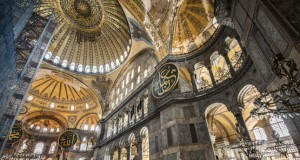An impressive figure of the architectural beauty hailing from the Byzantine-era, the Hagia Sophia at Istanbul’s Sultanahmet Square is still inspiring new studies, like the “Icons of Sound” project from Stanford University.
Having served as a cathedral, the mosque and now a museum over its 1,500-year-long lifespan, the Hagia Sophia is now the subject of a study from Stanford’s Center for Computer Research in Music and Acoustics (CCRMA) and its art history department.
Focusing on the interior of the Hagia Sophia, the study digitally imprints the museum’s resonating acoustics accompanied by visuals to create an immersive experience. The “Icons of Sound” project employs thorough musicological research and reveals the Hagia Sophia’s mystical acoustic character. “The Hagia Sophia challenges our contemporary expectation of the intelligibility of language. The wet acoustics of the Hagia Sophia blur the intelligibility of the message, making words sound like emanation, emerging from the depth of the sea. Not surprisingly, much of the ritual at the Hagia Sophia involved chanting and not recitative speech,” said the team on the project’s official website.
The team applies a method by using balloon pops that identify the space’s acoustic parameters, allowing them to introduce a computer model. This brings the experience that makes it seem as if listeners were in the Hagia Sophia. For the study, the research team has collaborated with chamber choir Cappella Romana, which has performed Early Music including Byzantine, Slavonic, and Gregorian chants by applying the computational model. The choir has already given a series of concert performances and continues to make listeners feel as if they were in the Hagia Sophia.
Built in the sixth century, the Hagia Sophia, which means “Holy Wisdom” in Greek, was converted to a mosque in 1453 when the Ottomans conquered Istanbul, in what was then called Constantinople. In 1935 it was transformed into a museum. The masterpiece features an immense dome supported by huge pillars,its walls sheathed with marble and decorated with mosaics.
Ask me anything
Explore related questions





